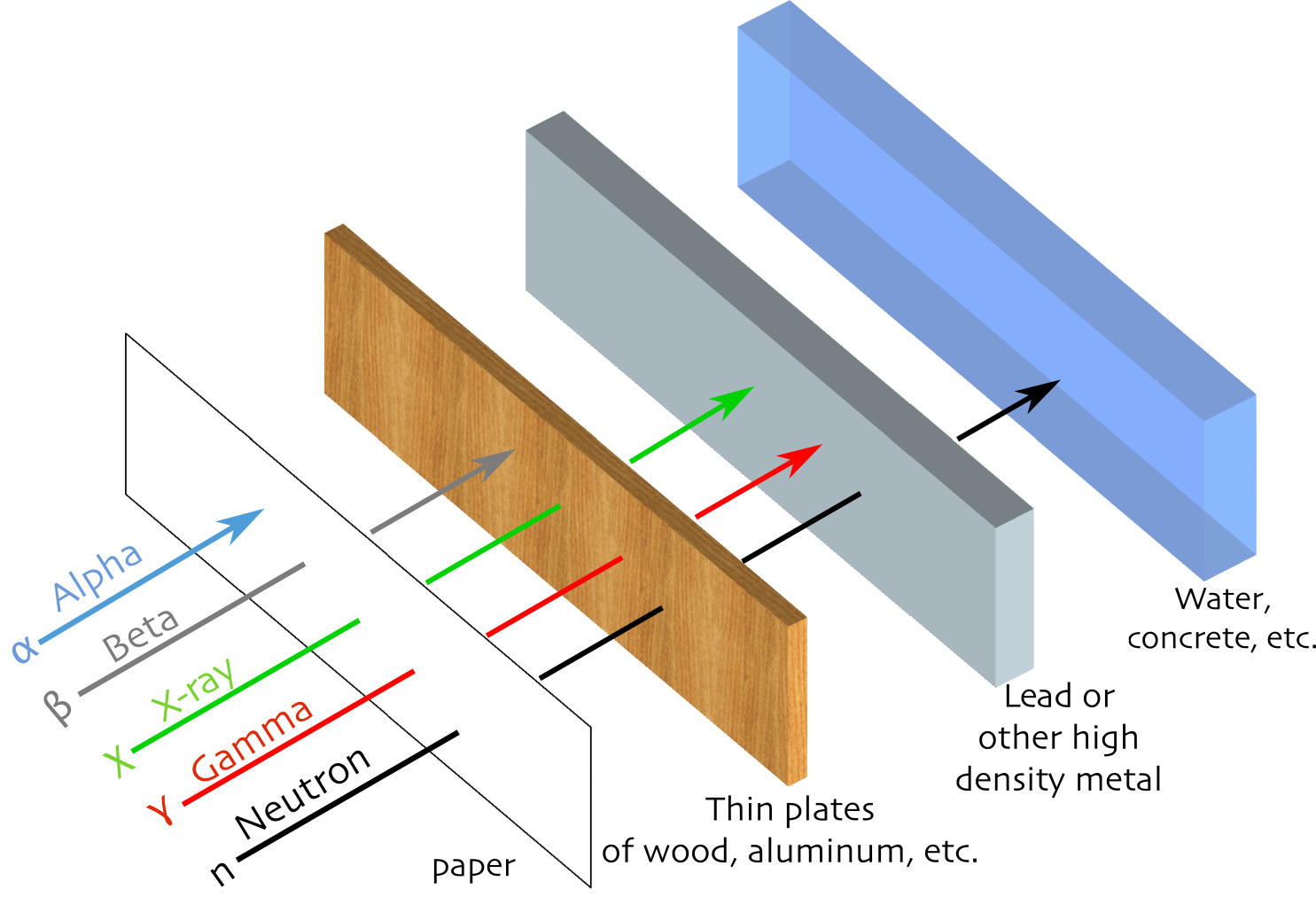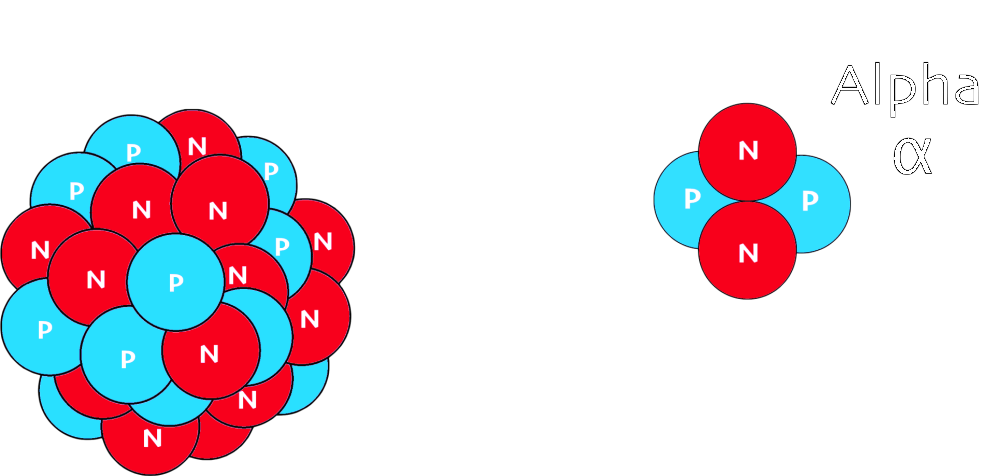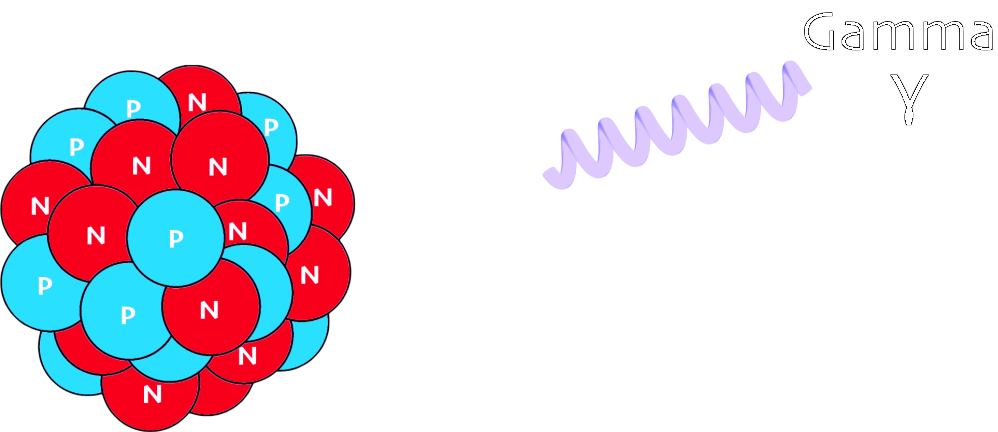THE SCIENCE BEHIND
The RayShield Series ® provides the best available protection against any radiation type. Combining the physical theories of electromagnetic radiation and nuclear physics with our medical knowledge of how radiation affects the organs of the human body, we have come up with a solution that minimizes the effects of being in a radioactive environment and working with radioactive sources. But what kind of radiation exists, how is it measured, and how does it affect the body?
The different kinds of radioactive decays and their attenuation properties are the following:

ALPHA-RADIATION
During alpha decay, a rather heavy nucleus from some radionuclides with high atomic numbers emits a Helium particle which usually travels at 5% of the speed of light. The particle quickly loses its energy due to collision with other particles and can thus quite easily be stopped by most materials. However, once inside the body, a radioactive alpha source is highly dangerous and damages many organs due to the significant energy released in the collisions. Therefore, it is vital not to have any alpha sources inhaled or resting on the clothes that can subsequently be inhaled and cause internal damage. The RayShield Series ® is guaranteed to protect against any interval of energetic alpha particles through the vest. Furthermore, the fact that it is easy to clean decreases the risk of inhaling alpha particles resting on the vest after maneuvering in a radioactive environment.

BETA-RADIATION
During beta decay, a high energy elementary particle, electron or positron, is emitted from unstable atoms with a speed very close to the speed of light. Beta particles can penetrate more than alpha particles and will relatively be stopped by a thin plate of aluminum. It can, to some extent, penetrate the human skin and cause epithelial and subepithelial damage, which can be very dangerous due to the high energy of the beta particles. This RayShield Series ® is guaranteed to protect completely against all beta radiation and rest products, primarily damaging gamma radiation, from interactions with matter. While some protection models available today only protect certain parts of the vital organs, the RayShield Series ® protects over 80% of the weighted radiation-sensitive organs and allows no beta particles to penetrate and damage the body.

GAMMA-RADIATION
During a gamma decay, the nucleus emits a quantum of energy in the form of an electromagnetic particle defined as a gamma particle. Since the gamma particle is only energy with no mass, it travels with the speed of light and thus makes few interactions with matter compared to the alpha and beta particles. Though gamma particles can cause damage to the human body, particularly for sources with high activity, the consequences can be disastrous. The fact that gamma radiation does not interact much with matter makes it almost impossible to stop completely.The RayShield Series ® revolutionizes the field of radiation protection providing a significant threshold shift for radiation control. While some protection models available today protects only against very low energetic radiation through a thin layer of lead, the RayShield Series ® protects completely against low to semi-high energy gamma radiation. Even for the highest gamma energies found in sites of nuclear disasters, it denies a significant fraction of particles, which no other protective equipment can do.

NEUTRON-RADIATION
Neutrons are emitted by only a few radionuclides and are produced in nuclear fission reactions. Energetic neutrons carry no charge like electrons and protons and do not react with matter (tissue, organs) similarly to the two others. Therefore, depending on its energy, it is much more penetrating than alpha and beta radiation and can sometimes be even more penetrating than gamma radiation. When the energetic neutron collides with the matter, it loses energy due to collisions with other atoms. These collisions break chemical bonds and damage the DNA, resulting in the disruption of atoms and molecules. Therefore neutron radiation is considered the most damaging to human tissue. Furthermore, neutron causes the emission of energetic alpha, beta, and gamma particles when it collides with stable nuclei, as in metals why we have developed the RayShield Series ® uniquely by drawing the path of the different particles, including the neutrons, through the most optimal characteristics and order of materials. By the intelligent combination of materials, this vest is the first and only one to protect against neutron radiation while simultaneously considering and protecting against the gamma decay radiation that the neutron creates during its collision processes.

MEASURING THE RADIATION DOSE
The quantity relevant for discussing the effect of radiation is the absorbed dose. In scientific literature, International System (SI) units are used, which is gray (Gy) and sievert (Sv).
1 Gy = 100 rad ; 1 Sv = 100 rem
When describing X-ray, beta, or gamma radiation, the gray and sievert are essentially equal but differ when describing alpha or neutrons, as discussed below.
The probability of stochastic effects of the radiation depends on the radiation type discussed above. This effect is considered by multiplying the energy of the particular type of radiation with a weighting factor. The weighting factor for photons (gamma) and electrons (beta) is 1 for all energies, while the weighting factor for alpha particles is 20 for all energies. The weighting factor for neutrons varies with the energy, from 5 for thermal neutrons (very low energy) to 20 for low to high energies (100 keV – 2 MeV). For higher energies, 2 – 20 MeV, the weighting factor decreases to 10, while it further decreases to 5 for really high energies, >20 MeV. Neutrons can produce photons that can do further damage in a process called radiative capture. The reason why low to high-energy neutrons are more damaging to the biological cell is that the radiative cross section increases with decreasing velocity (energy), and hence they produce more photons.
When describing the effect of absorbed radiation doses, we, therefore, use the “gamma equivalent” values. This means, as discussed above that alpha particles and neutrons can cause the same effect but at lower doses, dependent on the weighting factor.
Source: United States Nuclear Regulatory Commission
EFFECT OF RADIATION ON THE HUMAN BODY
The effect of radiation on the body varies depending on several factors, such as radiation dose and duration of exposure and tissue sensitivity.
In practice, the radiation dose absorbed depends on the source of radiation. The following sources of radiation are listed from least to most energetic.
- Natural occurring radiation sources are minor doses absorbed over a long time. These sources include radon gas, cosmic and solar radiation and natural internal radioactive elements.
- Man-made sources consist primarily of diagnostic X-rays and nuclear medicine.
- Radioactive isotopes consist of energetic alpha, beta, gamma, and neutrons. Particularly used in nuclear power facilities, health care, research labs, and the military.
The radiation dose of naturally occurring sources has no acute systemic effect on the body because of its low energies that resemble only 0,0032 Gy (0,32 rads) annually on average. Also, exposure to man-made sources resembles slight values, 0,0062 Gy (0,62 rads) annually on average due to its relatively low energies.
However, exposure to some of the radioactive isotopes is quite different due to the decay of energetic alpha, beta, gamma, and neutrons. Absorbing a single dose within a very short time damages more than absorbing the same dose given over a longer time (weeks to months).
The most common radioactive isotopes found as air release at nuclear accidents (leakage from nuclear power plants) at Chernobyl and Fukushima are:
| Isotope: | Decay energy [keV]: | Half life: |
| Caesium-137 (γ) | 661 (85%)* | 30 years |
| Tellurium-129 (γ) | 697 (6%) | 34 days |
| Antimony-125 (γ) | 603 (97%) | 2,75 years |
| Cerium-141 (γ) | 145 (48%) | 284 days |
| Zirconium-95 (γ) | 724/756 (49%/49%) | 64 days |
| Ruthenium-103 (γ) | 497 (88%) | 39 days |
| Niobium-95 (γ) | 765 (100%) | 35 days |
| Iodine-131 (γ) | 364 (82%) | 8 days |
| Xenon-133 (γ) | 81 (37%) | 5,27 days |
| Strontium-90 (β) | 546 | 28,8 year |
| Plutonium-238 (α) | 5.245 | 87,7 years |
*Only the highest yield percentage per decay are quoted
Energy source: Nuclear Structure and Decay Data, National Nuclear Data Center, Brookhaven National Laboratory
Depending on the activity of the sources the limit of how much radiation is allowed to be absorbed can easily exceed.
Even at moderate activity and energies, the radiation dose will be accumulated rapidly, which is why withdrawal and evacuation have been the only surviving strategies before the RayShield Series ®.
Irradiation of the entire body (or most of the body) to >0,7 Gy (>700 rads) over a concise (usually minutes) gives rise to radiation sickness, also known as Acute Radiation Syndrome (ARS). The symptoms of ARS are dependent on the radiation dose absorbed. Survival decrease with increasing dose. Therefore, higher doses result in more severe injuries and mild symptoms may occur as low as 0,3 Gy (300 rads).
The effects (and hence the symptoms) of radiation injury (ARS) are expressed at different stages also depending on the absorbed dose. Note that the absorbed doses are all quoted in gamma equivalent values.
| Stage: | Occurrence: | Usual symptoms |
| Prodromal stage | minutes to 2 days after exposure | Anorexia, nausea, vomiting(possibly diarrhea) |
| Latent asymptomatic phase | hours to 21 days after exposure | No symptoms for hours up to few weeks. |
| Overt systemic ilness phase | Hours to several months after exposure | Dependent on the specific syndrome |
| Recovery or death | Recovery: from several weeks up to 2 years. | Patients who do not recover dies within 2 months |
Depending on the usual absorbed radiation dose, three classical syndromes are described:
| Syndrome: | Dose [Gy]: | Occurrence of death: |
| Bone marrow syndrome | 0,7 – 10 (700 – 10.000 rads) | Within 6-8 weeks LD50/60 = 2,5 Gy (2500 rads) |
| Gastrointestinal syndrome | >10 (symptoms may occur as low as 6) (>10.000 rads) |
Within 2 weeks LD100 = 10 Gy (10.000 rads) |
| Cardiovascular / Central Nervous System syndrome | >50 (symptoms may occur as low as 20) (>50.000 rads) |
Within 48 hours |
LD50/60: is the necessary dose that causes death among 50% of the exposed population within 60 days.
LD100: is the necessary dose that causes death to 100% of the exposed population.
The symptoms of the different stages are expressed in details in the following table.
| Syndrome: | Prodromal stage | Latent stage: | Overt systemic illness stage: | Recovery/Death |
| Bone marrow(0,7-10 Gy) (700 – 10.000 rads) |
|
|
|
For large percentage of the population the cells in the bone marrow will begin to repopulate the marrow and then full recoveryDeath still may occur. The primary cause of death is infection and hemorrhage. |
| Gastrointestinal(GI)(>10 Gy) (>10.000 rads) |
|
Stem cells die in:
|
|
For exposure to >10 Gy, death will occur to 100% of the exposed population. |
| Cardiovascular (CV) / Central Nervous System (CNS) (>50 Gy) (>50.000 rads) |
|
Patient may be able to function partially |
|
No recovery is expected |
Source: Center for disease, control and response,
U.S. Department of Health & Human Service
With the greatest protective ability available, the RayShield Series ®, lowers the absorbed radiation dose significantly to ensure life saving support that actually works.
